Acerca de este curso
- Welcome to Chemical Biology: Concepts and techniques
- A very warm welcome to you, our new recruits! We'll start you off by acquainting you with the answers to big questions like why study chemical biology and what makes it special. We'll then show some highlights of the course that you are about to take. Finally, we want you to understand some fundamentals, so we are going to start off with some core concepts framed from the perspective of chemical biology.
- The Devil is in the Minutest Detail
- A picture used to paint a thousand words. But with the advent of multiple color imaging, microscopy can open a lens with which to view life that few other techniques are capable of. We are thus going to take you on a colorful tour that will show you specific fluorophores, explain why different fluorophores have different colors, and how to rationalize why a molecule is fluorescent. Then we will use these fluorophores in cells, to visualize important cellular processes.
- A ruler over time and space! Fluorescent assays to measure complex parameters in real time
- Here we will discuss how different fluorescent techniques have found fantastically useful applications to understand specific biological regulation processes in vitro and in live cells. We will focus on chromatin regulation and regulation of membrane tension as these are two systems which, without such techniques, we would not have the level of understanding we have today.
- Putting proteins to work for us
- The classical view of biological science is the laboratory worker working hard to understand a specific protein of interest. But through chemical biology, we have been able to employ proteins to do some of this important work for us. In this module you will learn how to deploy modified protein domains to perform custom-designed functions using light-based techniques as a readout.
- Making light work of it on a larger and larger scale
- In recent years numerous chemical biology processes have harnessed light-induced chemistry to control biology in terms of turning on or off inhibition, and exerting remote control of localization or chemical reactivity, amongst numerous other examples not covered here. We shed some light on these processes and exemplify the full spectrum of procedures possible using such approaches.
- Casting wide your net
- We've learned how complex biology is, and how resourceful chemical biologist have started to peer into this complex landscape using custom-designed probes. But given the huge complexity of biology, we often have to start from ground zero, screening for a specific molecule or identifying a target of an interesting molecule. Here we will discuss methods that are ideal for these purposes in cells and in vitro.
Cursos relacionados

GRATIS Aprendiendo a aprender: Poderosas herramientas mentales…
Deep teaching solutions
Español

GRATIS Programación para todos (Introducción a Python)
University of Michigan
Inglés

GRATIS The Science of Well-Being
Yale
Inglés

GRATIS Negociación exitosa: Estrategias y habilidades esenciales
University of Michigan
Inglés

GRATIS Primeros Auxilios Psicológicos (PAP)
Universitat Autónoma de Barcelona
Español


